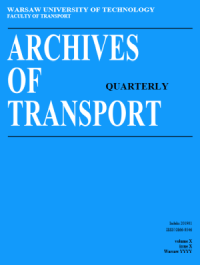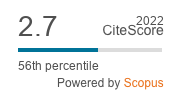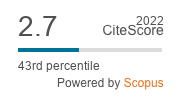Recommendations for the selection of parameters for shunting locomotives
DOI:
https://doi.org/10.5604/01.3001.0014.5650Keywords:
shunting locomotive, traction force, shunting movement, selection of parametersAbstract
Shunting is an integral part of the partial process. In 1520 mm gauge countries, shunting operations are performed by outdated locomotives, which are being replaced by modern models; the technical parameters best match the conditions of the shunting work performed. The article analyzes recommendations for the selection of parameters of shunting locomotives and the actual indicators of their work. On the basis of this analysis, a requirement was made on the necessity of compulsory consideration of the operating conditions of the locomotive when determining its technical characteristics. As the main technical parameters of shunting locomotives, the tractive power and starting tractive force are taken and their influence on the duration of an elementary shunting movement of the "acceleration-deceleration" type is investigated. This approach advises the regulatory documentation for the organization of shunting work. The developed mathematical model allows to carry out research on the influence of tractive power and starting tractive force on the time of acceleration and deceleration. Calculations of the time of the train's acceleration are carried out with varying their mass and the slope of the track at different values of the tractive power starting tractive force. The calculations were carried out for the mass of compositions 1000...5000 Mg for the profile slopes equal to 0 and 1.5 ‰. The speed of the finish of acceleration was taken equal to 15 and 25 km/h. The thrust starting tractive force varied in the range of 150...300 kN, the tractive power - 200 ... 1100 kW. According to the results of calculations, it was found that the reduction in the duration of the elementary shunting movement is more significantly affected by the power of the locomotive than by the starting traction force. The “saturation” effect was noted, in which a significant increase in power or traction force during starting does not cause a significant reduction in the acceleration time. In this regard, for shunting locomotives with AC traction drive, it is recommended to take a pulling force of an equal continuous traction force.
References
Babel, M., 2014. Teoreticheskie osnovyi i metodologiya vyibora ob'Yomov i tehnologiy modernizatsii teplovozov po kriteriyu stoimosti zhiznennogo tsikla [Theoretical foundations and methodology for the choice and technologies of modernization of diesel locomotives according to the criterion of life cycle cost]. (Doctor’s the-sis). Moscow, Nauchno-issledovatelskiy institut zheleznodorozhnogo transporta - The Railway Research Institute.
Boysen, N., Fliedner, M., Jaehn, F., & Pesc, E. (2012). Shunting yard operations: Theoretical aspects and applications. European Journal of Operational Research, 220, 1-14.
Buriakovskyi S.G., Maslii A.S., Panchenko V.V., Pomazan D.P., & Denis I.V. (2018). Issledovaniya rezhimov rabotyi teplovoza ChME3 na imitatsionnoy modeli (The research of the operation modes of the diesel locomotive CHME3 on the imitation model). Elektrotehnika i elektromehanika - Electrical engineering & electromechanics, 2, 59-62 [in Russian]. doi: 10.20998/2074-272X.2018.2.10.
Buriakovskyi, S., Maslii, A., & Pasko, O.(2019). Substantiation of the Way of Modernization of Shunting Diesel Locomotives. Civil Engineering Research Journal, Vol.7, Iss. 3: 555714. DOI: 10.19080/CERJ.2019.07.555714
Jacyna, M., Gołębiowski, P., & Urbaniak, M. (2016). Multioption model of railway traffic organization including the energy recuperation. Communications in Computer and Information Science, 640, 199-210.
Jacyna, M., & Krześniak, M. (2018b). Computer Support of Decision-Making for the Planning Movement of Freight Wagons on the Rail Network. Lecture Notes in Networks and Systems, 21, 225-236. https://doi.org/10.1007/978-3-319-64084-6_21.
Jacyna, M., Szczepański, E., Izdebski, M., Jasiński, S., & Maciejewski (2018a). Characteristics of event recorders in automatic train control systems. Archives of Transport, 46(2), 61-70. https://doi.org/10.5604/01.3001.0012.2103
Kalinčák D., Bartík Ľ., & Grenčík, J.(2012). The hybrid traction – the way of fuel utilization improvement. In Proc. of RAILCON ´12, XV scientific – expert conference on railways, 1-4.
Kalinčák D., Mikolajčík M., & Grenčík J (2015). The possibilities of fuel economy in rail-ways – The hybrid traction propulsion. Logistika, 4, 3912-3921.
Kamaev, A.A (1981). Konstruktsiya, raschet i proektirovanie lokomotivov (Construction, calculation and design of locomotives). Moscow: Mashinostroenie [in Russian].
Kukulski, J., Jacyna, M., & Gołȩbiowski, P. (2019). Finite element method in assessing strength properties of a railway surface and its elements. Symmetry, 11(8). https://doi.org/10.3390/sym11081014
Lyubarsky, B.G., Ryabov, E.S. (2017). The concept of choosing a traction electric drive for a shunting electric locomotive. // Lokomotivy. Transport and technological complexes. XXI century: materials of the V International scientific and technical conference, pp.198-204.
Merkisz, J., Jacyna, M., Merkisz-Guranowska, A., & Pielecha, J (2014). The parameters of passenger cars engine in terms of real drive emission test. Archives of Transport, 32(4), 43-50.
Metodichni vkazivki z viznachennya norm chasu na manevrovi roboti, yaki vikonuyutsya na zaliznichnomu transporti (Methodical instructions for the development of norms for an hour on the maneuvers of robots, such as vikonuyutsya on public transport): order of Ukrzaliznytsia 03/25/2003 p. No. 72-TsZ., Kyiv.
Mikhalchenko, G.S., Kashnikov, V.N., Kossov V.S. & Simonov (2006). Teoriya i konstruktsiya lokomotivov (Theory and construction of loco-motives), Moscow: Marshrut [in Russian].
Riabov, Ie.S. (2015). K voprosu sozdaniya manevrovyih elektrovozov (On the issue of creation of shunting electric locomotives). Informatsiyno – keruyuchisistemi na zaliznichnomu transporti -Information and control systems on railway transport, 3, 69-72 [in Russian].
Schasfoort, B.B.W., Gkiotsalitis, K., Eikenbroek, O.A.L., van Berkum, E.C. (2020). A dynamic model for real-time track assignment at railway yards. Journal of Rail Transport Planning & Management, 14, 100198.
Sirotenko, Yu. V. (2014). Viznachennya potuzhnosti manevrovogo teplovoza z urahuvannyam mistsya yogo ekspluatatsiyi (Determining the power of a shunting locomotive taking into account the place of its operation). Shidnoevropeyskiy zhurnal peredovih tehnologiy - East European Journal of Advanced Technologies, 1(8), 41-45 [in Ukrainian].
Toruń, A., Sokołowska, L., & Jacyna, M (2019). Communications-based train control system - Concept based on WiFi LAN network. Transport Means: Proceedings of the International Conference, 2019,. 911-915.
Traction calculation method for shunting work (2017). Approved by order of JSC Russian Railways No. 181r dated January 30.
Urbaniak, M., Kardas-Cinal, E., & Jacyna (2019). Optimization of energetic train cooperation. Symmetry, 11(9). https://doi.org/10.3390/SYM11091175.
V "Ukrzaliznyitse" rasskazali, naskolko iznoshenyi ih lokomotivyi (Ukrzaliznytsia told how worn out their locomotives are) (n.d.). delo.ua. Retrieved from https://delo.ua/business/vukrzaliznyce-rasskazali-naskolko-iznosheny-ih-lokomotivy-346214 [in Russian].
Verlan, A.I., Berezovy, N.I., Vernigor, R.V., & Shepeta, A.M. (2012). K voprosu o metodike rascheta rabochego parka manevrovyih lokomotivov pod'ezdnogo puti (On the method of calculating the working fleet of shunting locomotives of the approach road). Transportni sistemi ta tehnologiyi perevezen - Transport systems and transportation technologies, 3, 15-19 [in Russian].
Voron'ko, V. A. (2005). Obosnovanie vybora parametrov manevrovyh i promyshlennyh teplovozov s uchetom uslovij jekspluatacii [Justification of the choice of parameters for shunting and industrial diesel locomotives, taking into account operating conditions]. (Candidate’s thesis). Russian university of transport (MIIT). Moscow [in Russian].
Yatsko, S., Sidorenko, A., Vashchenko, Ya., Lyubarskyi, B., & Yeritsyan, B.(2019). Method to Improve the Efficiency of the Traction Rolling Stock with Onboard Energy Storage. International journal of renewable energy research, Vol. 9, No. 2, 848-858.
Downloads
Published
Issue
Section
License
Copyright (c) 2024 Archives of Transport journal allows the author(s) to hold the copyright without restrictions.

This work is licensed under a Creative Commons Attribution 4.0 International License.











